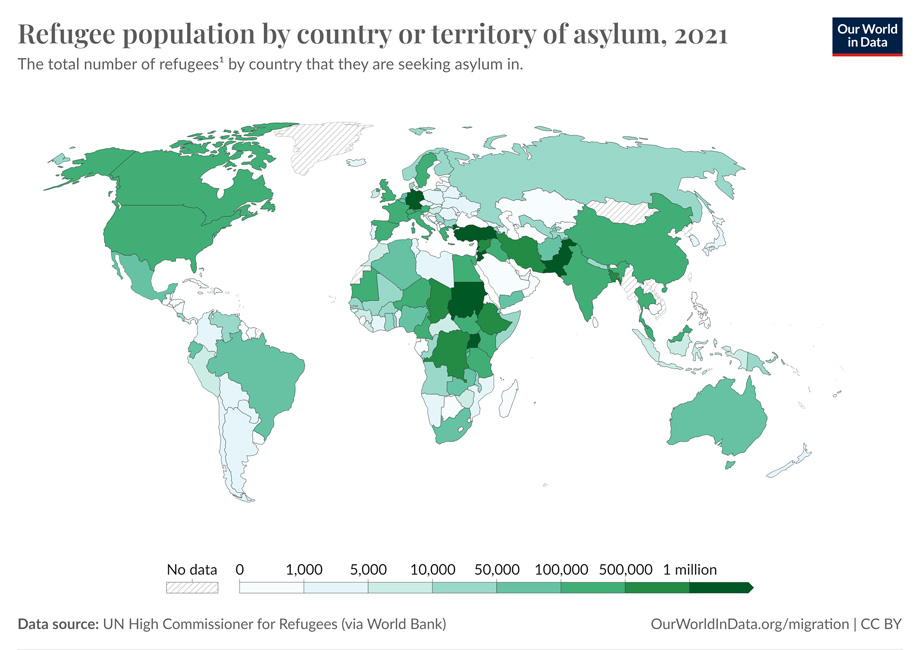Dr Matilde Rosina is a Lecturer in Global Challenges at Brunel University London
Since its introduction in 1951, the UN refugee convention has been the basis for the global refugee system. It defines who a refugee is and outlines the rights they are entitled to.
More than 70 years later, the world is more connected and the nature of migration and asylum has changed. UK home secretary James Cleverly (as well as his predecessor Suella Braverman) has suggested that such migration treaties are no longer fit for purpose.
In a recent speech in the US, Cleverly rightly pointed out that migration has “been accelerated … by modern technology and transport”, and that globally today, 3.6% of people are migrants. Cleverly did not mention that this proportion has been surprisingly stable over the past 60 years.
However, we need to draw a distinction here between migration generally and refugee numbers. While migration generally has been stable, refugee numbers have more than doubled in the past decade, going from almost 17 million in 2013 to 36 million in 2023. This has been primarily driven by protracted conflicts in Syria, Afghanistan and Ukraine. These have led millions to flee war, persecution and violence in their home countries.
With that in mind, Cleverly has a point: the global asylum system is facing significant challenges. This is because some countries are taking more responsibility than others. It is not, therefore, a truly global system.
Today, 70% of refugees are hosted in countries neighbouring where the people flee from. These are most often developing countries. In Lebanon, refugees comprise 15% of the population. In sharp contrast, in the UK the proportion stands at 0.5% and in Japan at 0.01% (based on UN refugee agency and World Bank data for 2022).

View original interactive map on OurWorldInData.org
While a few countries take most of the responsibility for refugees, many others shun cooperation. The result is that very few refugees are able to reach safety. According to the UN, globally, only about 4% of refugees in 2022 were able to access resettlement schemes and travel to a destination country safely and legally.
Many countries offer safe and legal routes to people in need of protection. The UK resettled 4,396 people in 2023, and has humanitarian visa schemes for people from Ukraine, Hong Kong and Afghanistan. But there are many more people seeking protection from elsewhere in the world. In the absence of safe and legal routes, many will attempt to enter countries like the UK through irregular means, such as via small boats.
The refugee convention outlines what states must do to offer protection and support and to whom. It does not, however, have any mechanisms to make sure responsibility is equally shared between states.
Political challenges
Cleverly correctly noted that “any approach to global migration that is not rooted in international cooperation is doomed to fail”. The answer is not to simply do away with current migration treaties, but to build on them, creating a system that meets refugees’ needs for protection while requiring states to fairly share responsibility.
Scholars have long explored the possibility of a legally binding mechanism to ensure that refugee protection is responsibly shared. But such a system seems impossible in the current political climate.
Wealthier countries are sceptical of taking more refugees – and anti-immigration sentiment is on the rise. The US, Australia and Italy all failed to endorse recent, non-binding, international agreements on responsibility-sharing for migration and refugee protection. Much of the opposition to these agreements was promoted by far-right and anti-immigrant groups online.
Despite this political difficulty, there could be ways to incentivise states to take more responsibility, without a legally binding system. One suggestion is to introduce a global index, run by the UN refugee agency, that publicly ranks countries by how much they are doing to protect refugees.
States contribute in different ways to refugee protection, including by hosting refugees, by creating legal pathways to protection and by providing funds to the UN refugee agency. An index that accounted for all of this would make it clearer which countries are doing more or less.
Evidence from other sectors suggests that governments can be incentivised to make changes in order to improve their image and reputation. For example, naming and shaming by the UN and non-governmental organisations has been found to reduce state-sponsored murder such as during civil wars, and global indices can help combat corruption.
International reputation can play a role in the development of migration policies too, as we saw with the introduction of generous migration policies for Ukrainians.
From safety to integration
A global refugee system also requires a more cooperative, less polarised discussion about migration – one that recognises the effect the phenomenon can have on some local communities, but also refugees’ immense struggles, and European economies’ need for foreign workers.
More work needs to be done in host countries to help refugees integrate and avoid marginalisation and discrimination. This could be through cultural exchanges between citizens and refugees, such as sport, cooking or language classes.
Several studies have shown that promoting citizens’ interactions with, and exposure to, migrants and refugees can enhance mutual understanding and reduce prejudice.
Research suggests that sharing immigrants’ individual stories, rather than figures and facts, might have a greater role in encouraging positive views of immigration.
This article is republished from The Conversation under a Creative Commons license. Read the original.
Reported by:
Press Office,
Media Relations
+44 (0)1895 266867
press-office@brunel.ac.uk